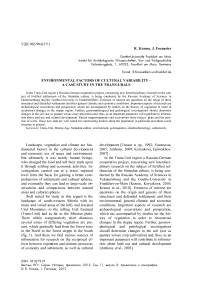Environmental factors of cultural variability - a case study in the Trans-Urals
Автор: Краузе Р., Форнасье Й.
Журнал: Вестник Новосибирского государственного университета. Серия: История, филология @historyphilology
Рубрика: Культурная вариативность на археологических памятниках Урала и западной Сибири в эпоху Палеометалла
Статья в выпуске: 3 т.11, 2012 года.
Бесплатный доступ
In the Trans-Ural region a Russian-German cooperative project, concerning new interdisciplinary research on the subject of fortified settlements of the Sintashta culture, is being conducted by the Russian Academy of Sciences in Ekaterinenburg and the Goethe-University in Frankfurt/Main. Foremost of interest are questions on the origin of these structured and defended settlements and their general climatic and economic conditions. Important aspects of research are archaeological excavations and prospection, which are accompanied by studies on the history of vegetation in order to reconstruct changes in the steppe region. Further, geomorphological and pedological investigations should determine changes in the soil (use as pasture versus crop cultivation) and, thus, as an important parameter will contribute to information about land use and cultural development. Recent magnetogramms and excavations show houses` plans and the position of wells. These new data are well suited for constructing models about the population in particular and about social structure in general.
Trans-ural, bronze age, sintashta culture, environment, geomagnetics, dendrochronology, settlements
Короткий адрес: https://sciup.org/14737754
IDR: 14737754


